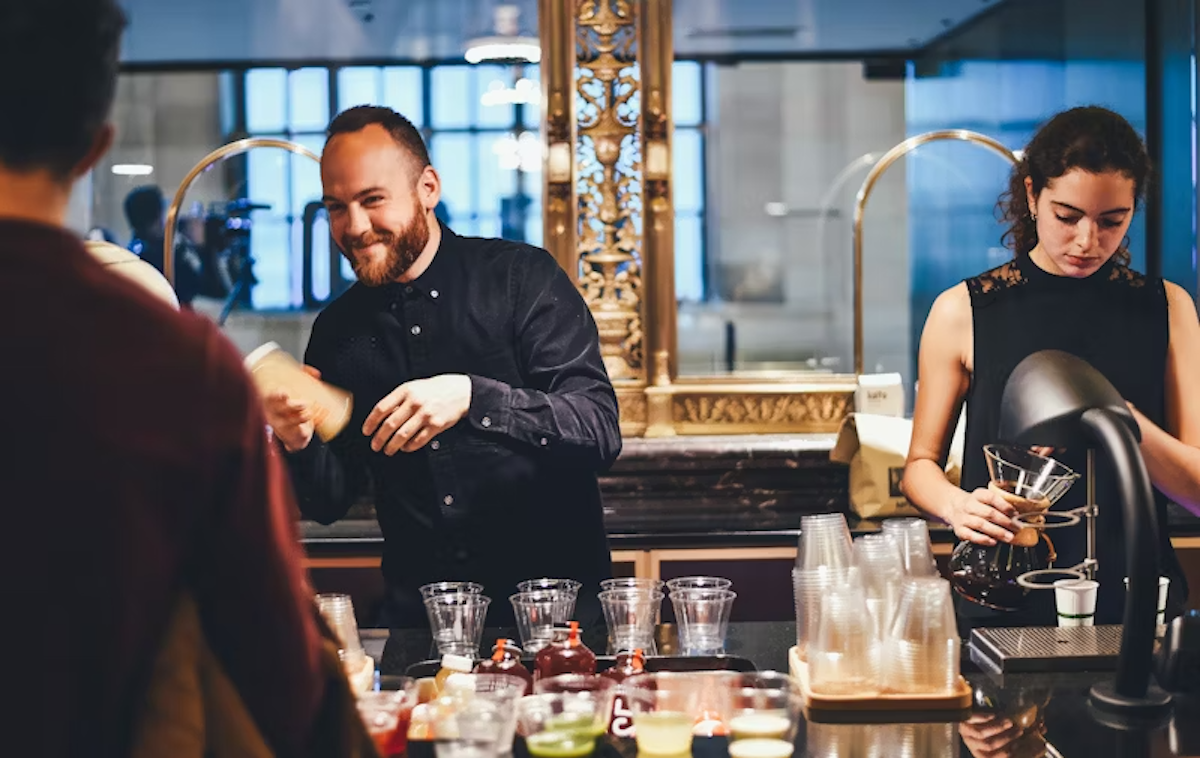What are the Average Restaurant Sales per Month by Category?
Breaking down average restaurant sales per month gives restaurant owners, managers, and investors a clearer view of how the business is performing....
Platform
Combining online ordering, loyalty, omnichannel messaging, AI insights, and payments in one platform. Paytronix delivers relevant, personal experiences, at scale, that help improve your entire digital marketing funnel by creating amazing frictionless experiences.
A Complete Customer Experience Platform
Online Ordering
Acquire new customers and capture valuable data with industry leading customization features.
Loyalty
Encourage more visits and higher spend with personalized promotions based on individual activity and preferences.
Catering
Grow your revenue, streamline operations, and expand your audience with a suite of catering tools.
CRM
Build great customer relationships with relevant personal omnichannel campaigns delivered at scale.
Artificial Intelligence
Leverage the most data from the most customer transactions to power 1:1 marketing campaigns and drive revenue.
Payments
Drive brand engagement by providing fast, frictionless guest payments.
Solutions
We use data, customer experience expertise, and technology to solve everyday restaurant and convenience store challenges.
Contactless Experiences
Accommodate your guests' changing preferences by providing safe, efficient service whether dining-in or taking out.
Customer Insights
Collect guest data and analyze behaviors to develop powerful targeted campaigns that produce amazing results.
Marketing Automation
Create and test campaigns across channels and segments to drive loyalty, incremental visits, and additional revenue.
Mobile Experiences
Provide convenient access to your brand, menus and loyalty program to drive retention with a branded or custom app.
Subscriptions
Create a frictionless, fun way to reward your most loyal customers for frequent visits and purchases while normalizing revenues.
Employee Dining
Attract and retain your employees with dollar value or percentage-based incentives and tiered benefits.
Order Experience Builder
Create powerful interactive, and appealing online menus that attract and acquire new customers simply and easily.
Loyalty Programs
High-impact customizable programs that increase spend, visit, and engagement with your brand.
Online Ordering
Maximize first-party digital sales with an exceptional guest experience.
Integrations
Launch your programs with more than 450 existing integrations.
Loyalty Programs
Deliver the same care you do in person with all your digital engagements.
Online Ordering
Drive more first-party orders and make it easy for your crew.
Loyalty Programs
Digital transformations start here - get to know your guests.
Online Ordering
Add a whole new sales channel to grow your business - digital ordering is in your future.
Integrations
We work with your environment - check it out.
Company
We are here to help clients build their businesses by delivering amazing experiences for their guests.
Meet The Team
Our exceptional customer engagement innovations are delivered by a team of extraordinary people.
News/Press
A collection of press and media about our innovations, customers, and people.
Events
A schedule of upcoming tradeshows, conferences, and events that we will participate in.
Careers
Support
Paytronix Login
Order & Delivery Login
Resources
Learn how to create great customer experiences with our free eBooks, webinars, articles, case studies, and customer interviews.
FlightPaths are structured Paytronix software onboarding journeys designed to simplify implementation and deliver maximum ROI.
See Our Product In Action
E-Books
Learn more about topics important to the restaurant and c-store customer experience.
Reports
See how your brand stacks up against industry benchmarks, analysis, and research.
Blog
Catch up with our team of in-house experts for quick articles to help your business.
Case Studies
Learn how brands have used the Paytronix platform to increase revenue and engage with guests.
Is your brand tapping into these three unshakeable pillars of guest loyalty in 2025?
6 min read
Mar 28, 2025

Running a restaurant demands careful planning, investments, analytics, and building an effective team to navigate every stage of growth and adaptation in today's competitive market. That’s why understanding staff titles and job roles is crucial for smooth operations, guest satisfaction, and overall team efficiency.
Studies show that companies with clearly defined roles, restaurant training programs, and responsibilities experience higher productivity. A well-structured restaurant staff is key to maintaining commitment, motivation, and teamwork—factors that help reduce turnover and minimize hiring and training costs.
According to research by the National Restaurant Association, 8 in 10 restaurant owners in the United States began their careers in entry-level positions. This highlights the importance of creating a clear and supportive structure within your team. In this guide, we’ll share strategies for establishing staff titles, dress codes, and handbooks—key elements in building a strong and cohesive team.
A well-organized team is essential in a fast-paced environment like a restaurant. Proper training, clear roles, effective communication, fair compensation, and strong leadership are key to maintaining high retention rates, ensuring staff satisfaction, and delivering excellent customer service.
Clearly defined roles are crucial for avoiding confusion and overlap. By assigning specific responsibilities to servers, kitchen staff, and managers, each team member knows their duties, leading to improved efficiency and team morale.
Hiring the right employees for your business is just the beginning of building an effective team. Once hired, there’s a long path ahead, which includes restaurant training, assigning roles, guiding, and developing a cohesive group. Understanding these employees' titles is critical for creating a strong team, fostering accountability, and ensuring that every operation runs smoothly.
Below, we’ll explore the 16 most common staff titles in both the front-of-house (FOH) and back-of-house (BOH), each with its own unique set of responsibilities.
In the FOH, staff members are the face of the restaurant. They directly interact with guests and create the first impression of your business. Having the right people in the right FOH roles is essential for smooth service and customer satisfaction. Here are the six roles you’ll find in the FOH:
Behind the scenes, these staff members handle food preparation, cleanliness, and overall kitchen operations. A well-organized kitchen is key to delivering high-quality dishes to your customers. Here are six roles of the BOH:
While FOH and BOH staff are critical, there are a few more positions that help ensure your restaurant thrives. Here are four additional roles:

A clear dress code is essential not only for professionalism and hygiene but also for reinforcing the restaurant’s brand. It’s not just about having a “uniform” but about how the business presents itself to the world. It reflects the style, identity, and cleanliness of the restaurant, making it an integral part of the customer experience. Here’s what to wear whether you’re a FOH or BOH restaurant employee:
It's important to balance both the restaurant's theme and safety standards while being mindful of your team’s comfort and cultural differences. Establishing a policy that is inclusive, clear, and respectful will help ensure your staff feels confident and represented, while maintaining a professional image for the restaurant. Here are four tips to guide you:
A well-structured restaurant staff handbook helps set clear guidelines for employees, ensuring smooth operations and alignment with the restaurant’s goals. Here are the five sections to include in your restaurant’s staff handbook:
Restaurant staff training is one of the most common concerns for new employees. It’s not just about teaching the operations; it's about providing guidance, building confidence, and promoting good communication within the team. A lack of training or not asking enough questions in the early stages can lead to confusion and mistakes. Here are the best practices for onboarding new staff members:
Providing constructive feedback and reviewing performance regularly can help restaurant employees grow in their roles and stay motivated. It’s an opportunity to identify strengths, address areas for improvement, and ensure everyone is on track with their development.
Managing a dedicated restaurant team is key to keeping service consistent and creating a positive work environment. High turnover rates can drive costs and lead to uneven customer service, so businesses aim to minimize it. Here are seven tips to consider:
Managing a successful restaurant staff involves many moving parts, and understanding common questions about staffing can help streamline operations. Here are answers to some of the most frequently asked questions:
First, identify peak hours and days to ensure adequate coverage. Then, assign shifts based on employees availability, preferences, and skill sets, while considering legal requirements such as rest periods. Using restaurant staff software is crucial to streamline the process and avoid errors. Finally, remain flexible to accommodate last-minute changes while maintaining fairness and consistency.
The 5-2 5-3 work schedule template is a system that divides workdays into a pattern. Employees work five consecutive days, followed by two days off, then five days of work again, and three days off. This schedule is often used in industries like hospitality to provide consistent work hours while giving employees longer periods off for rest and recovery.
The hierarchy of restaurant staff typically follows a chain of command to ensure that each position is accountable for specific tasks. The general structure includes: Owner/Operator, General Manager, Assistant Manager, FOH staff, and BOH staff.
The positions at a restaurant are divided into front-of-house (FOH) and back-of-house (BOH). Common FOH roles include hosts, servers, bartenders, and food runners. BOH's roles include executive chefs, sous chefs, line cooks, prep cooks, dishwashers, and kitchen porters. Other specialized positions may include sommeliers, pastry chefs, and marketing coordinators, depending on the restaurant’s needs.
Building and managing a restaurant team goes beyond just hiring—it’s about defining clear roles, setting expectations, and creating an environment where employees can thrive. From front-of-house service to back-of-house operations, every position plays a role in delivering a great guest experience. A well-structured training program, fair policies, and ongoing feedback help ensure consistency, while competitive pay and growth opportunities keep staff motivated.
Looking to streamline operations and support your team? Book a demo to see how Paytronix solutions—loyalty, marketing, online ordering, gift and comp, and more—can help. Plus, download our guide, and you’ll see how loyalty programs can improve the overall guest experience while making your restaurant more efficient.


Breaking down average restaurant sales per month gives restaurant owners, managers, and investors a clearer view of how the business is performing....

Understanding the cost of goods sold (COGS) is crucial for maintaining healthy profit margins in both restaurants and convenience stores (c-stores)....

Menu engineering is a proven strategy to increase restaurant profitability. By analyzing sales data, you can refine your offerings to focus on...